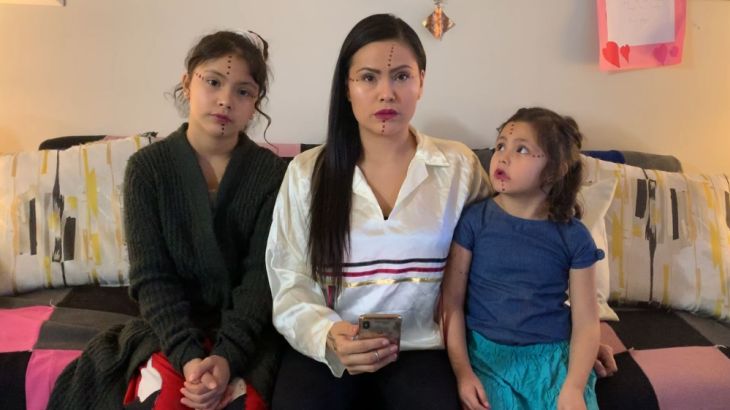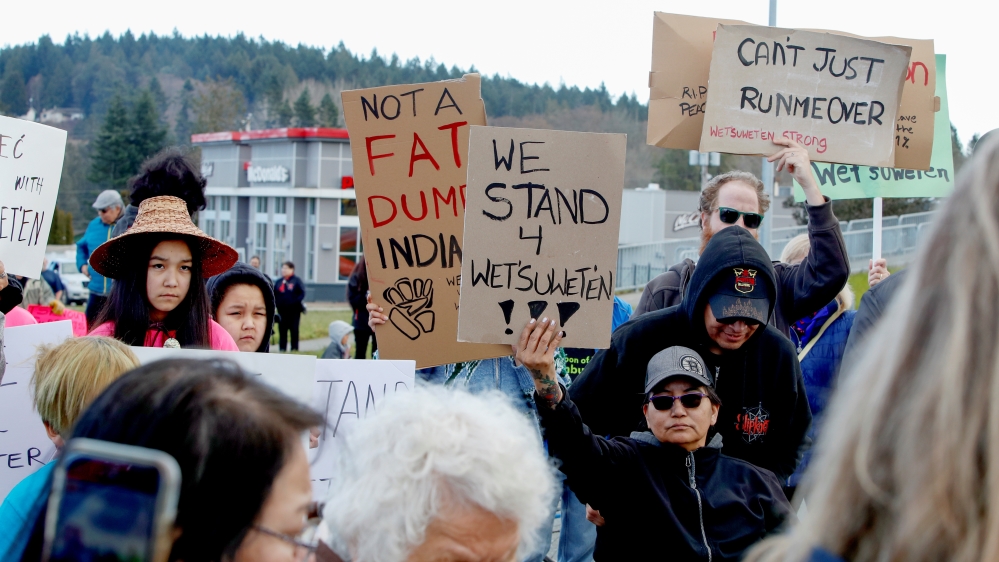First Nations receive death threats over Canada pipeline battle
Indigenous people report a rise in racist attacks as tensions grow over construction of the Coastal GasLink pipeline.

Six-year-old Dani looks inquisitively into the eyes of her mother, searching for reassurance. It is not the first time Dani has asked her mother, Michelle Alexis, whether they may be harmed because of the colour of their skin. In fact, it is almost a regular occurrence. And lately, the threats are feeling more ominous, Michelle says.
A single parent of two daughters, Dani and 10-year-old Teyla, Michelle survived a difficult childhood – one filled with abuse and dysfunction and spent in and out of the foster care system.
Keep reading
list of 4 items‘Feel less and less like playing’: Vinicius Jr in tears over racist abuse
‘Rendered invisible’: A wave of anti-Arab violence tests US hate crime laws
Germany bans far-right Austrian nationalist Martin Sellner from entry
The family are First Nations, members of the Alexis Nakota Sioux Tribe in Alberta, Canada.
In early February, Michelle says she and her girls were called “dirty” and were the target of other racial slurs by a white woman at a mall in Edmonton.
It inspired her to start the Peace of Change Movement, which seeks to bring together people of different races and cultures to celebrate who they are and to counter racism.
Michelle organised a traditional tribal round dance at the mall that brought out hundreds of participants last week.
But racial tensions have escalated in Canada since then.
“I turn on the TV, it’s [racism] there,” says Michelle from her apartment in Edmonton. “At my kids’ school, it’s there. When we get groceries it’s there. Online it’s there. My kids are afraid – I’m not going to lie.”

‘Kill a native protester’
The racism comes against a backdrop of growing tensions over the Coastal GasLink pipeline.
Wet’suwet’en First Nation hereditary chiefs are fighting to stop construction of the pipeline on their traditional territories in British Columbia. Demonstrations and infrastructure blockades have been taking place nationwide in support of the Wet’suwet’en, with many Indigenous tribes asserting their land and Indigenous rights in what has become a standoff with industry and the provincial and federal governments.
The blockades have resulted in approximately 1,500 temporary job layoffs, backed up ports and delayed the delivery of essential goods to Canada’s eastern provinces.
Meanwhile, the Canadian government held a meeting of the House of Commons public safety and national security committee on Thursday, where an MP from the opposition Conservative Party, Doug Shipley, asked the Minister of Public Safety and Emergency Preparedness, Bill Blair, if the rail blockades constituted an act of terrorism under the country’s criminal code. Blair replied that they did not.
Still, there has been a backlash from some non-Indigenous Canadians, which has taken the form of threats, slurs and attacks online and in person against Indigenous people.
Among some of the comments made online towards Indigenous people over the past week and documented by Al Jazeera were: “Why not just round them all up and into the gas chamber?” and “I’m sure my truck could kill a native protester at 40km or less lmao.”
‘This is a threat’
Since Ontario Provincial Police arrested 10 Tyendinaga land defenders blocking the railway through their territory on Monday, the Mohawks there have pushed back. TV reports in mainstream Canadian media stream images of Mohawks setting tyres on fire and throwing them onto the railway track in an attempt to block the passage of trains.
On February 26, an email was sent to Wet’suwet’en media representatives and the Tyendinaga township, threatening the Wet’suwet’en hereditary chiefs and Tyendinaga Mohawk tribes.
“You and your punk friends, the Mohawk warriors, need to call off the blockades. If you don’t you will find a bomb in your mailbox, and your parents will be in danger. This is a threat, you are on notice,” the email said.
The police say they only investigate threats if the people on the receiving end make a complaint. But Freda Huson, a spokesperson for the Unist’ot’en, a house of the Wet’suwet’en, told Ricochet Media, “We didn’t know what to make of it or what to do with it. We don’t trust the police to actually do anything with it.”

Ottawa’s Assembly of Seven Generations (A7G) Indigenous youth group says its members have been receiving death threats ever since they showed support for the Wet’suwet’en by participating in a rally that closed down streets in downtown Ottawa on Monday.
Since then, A7G spokeswoman Dani Lanouette says her group has filed two official complaints to the Ottawa Police Service (OPS).
Back in Alberta, two videos were reported to police in Ponoka on February 28. The videos, which had been posted on Snapchat and Facebook, appear to show teenagers using racist and sexist slurs, including one who says: “I’ll scalp you this time, how ’bout that?”
Deputy Executive Director and Senior General Counsel of the Canadian Human Rights Commission (CHRC) Monette Maillet fears that hate speech left unchecked could lead to tragic consequences.
“History has shown that,” she says. “[The Rwandan genocide, the Holocaust] they started with hate speech. Hate dehumanises. It seeks the destruction of a people.”
The CHRC does not have any jurisdiction to deal with online hate speech and even if they did, she says they would not have the capacity to handle the “overwhelming” number of cases. That jurisdiction rests with the provincial police, but proving intent to incite hatred can be a long and drawn-out process. As a result, there is little protection for people on the receiving end of hate speech and threats on social media, Maillet stresses.
‘We pray’
“How do we fight back?” Dani asks her mother.
“We pray,” says Michelle, gently.
She tells her daughters that they are important, that they are meant to be here, just like anyone else, and that Waka (Creator) is watching over them.
Michelle wishes others would understand her worldview – a Nakota Sioux one that looks at this chaotic situation in a different way. To Michelle, what is unfolding is an Indigenous sacred responsibility that mainstream society does not comprehend. This conflict over a pipeline is really about standing up for the future, she says.
“We have to advocate for our relations – the land, the animals, the water,” she explains. “But I pray for the people who inflict these traumatic things on us. I ask him [the Creator] to wrap his arms around those who don’t understand.”

The case of Colten Boushie
Meanwhile, just over 500km east, in the prairie city of Saskatoon, Saskatchewan, Erica Violet Lee is taking a break after several days of overseeing a rail blockade set up there. She is a community organiser and a graduate of the Social Justice programme at the University of Toronto. She is also a member of the Thunderchild First Nation and supports the Wet’suwet’en hereditary chiefs.
Lee says that she and others participating in the blockade were subjected to threats from a group of counter-protesters.
“They were yelling at us saying racial slurs like ‘Indians’, ‘lazy’ and assumed none of us had jobs,” she says. “It was hard not to talk back. We are out to defend future generations – we weren’t doing anything illegal.”
Lee says some of the protesters shouted about Colten Boushie.
A 22-year-old from Red Pheasant First Nation, Colten Boushie was shot dead on a rural Saskatchewan farm in 2016, after reportedly stopping with four friends to seek help for a flat tyre. An altercation ensued with the owner of the farm, Gerald Stanley, who suspected them of trying to steal a quad bike.
Stanley shot Boushie at close range and claimed self-defence. Boushie died on the spot. Protests broke out across Canada following Stanley’s 2018 trial and acquittal for manslaughter.
“They [the counter-protesters] brought up Colten Boushie and said that he deserved to die.”
Lee says the police showed up to keep the counter-protesters away from the demonstrators, but, concerned for their safety, Lee’s group eventually decided to pack up their demonstration and head home.
‘Guided by a higher power’
In Winnipeg, the capital of Manitoba, directly east of Saskatchewan, is the largest urban population of Indigenous people in Canada. That is where Sean Parenteau, a videographer and member of the Duck Bay and Cross Lake First Nations, lives.
He says he has experienced a rollercoaster of emotions recently.
Parenteau attended a rally in support of the Wet’suwet’en in downtown Winnipeg on Wednesday and says he came face to face with an angry white man who was yelling racial slurs at him. As Parenteau backed away from him, he accidentally knocked over an elder who was standing behind him.
“He was aggressive from the start. You could see the ugly face on him,” he explains.
Parenteau says he wanted to fight back, but instead alerted nearby security guards, who took the man away.
That night, Parenteau says he cried in the arms of his wife.
“I’m just fed up with what I see, this racism,” he explains.
“But we’re [Indigenous people] going to get stronger, educated. And we are guided by a higher power.”
‘What native communities go through every day’
After the Canadian National Railway shut down its entire network east of Toronto due to the actions of land defenders along the railway line near Belleville, Ontario, Canadians on the east coast started rationing propane stocks.
Ruby Paul, a resident of Cape Breton, Nova Scotia, in eastern Canada, says she is monitoring news reports for updates on propane supplies but is not too worried about running out yet. Her concerns are focused on the mounting tensions.
“It’s unfortunate that this had to happen. I feel for the people that are struggling in this predicament,” says Paul, who is a Mi’kmaq member of the Eskasoni First Nation.
“But people are forgetting and not considering what native communities go through every day. This is what it has to take for the First Nations People to be heard from the government and general public. First Nations have had their land taken away from them and [been] promised that the government will forever consider the best for the preservation of rights, land, resources of Mother Earth.”
Paul says she tries not to read the racist comments on social media because they are “hurtful”.
On February 19, a group of non-Indigenous people in Alberta dismantled a blockade set up west of Edmonton. About a dozen protesters left the area after pieces of wood, signs and camping materials were taken off the tracks and thrown into the back of a pick-up truck by those removing the blockade.
The leader of a separatist movement there known as “Wexit” spearheaded the takedown. “Hey Trudeau! Do you like how we dealt with the Edmonton rail blockade today?” Peter Downing wrote on his Facebook page following the blockade removal. “That’s how we deal with scum-sucking communist bottom-feeders in Alberta!”
Less than a 10-minute drive from where that scene played out, Michelle tucks her girls in at night and prays with them. She lights a smudge and the room fills with the comforting smell of sweetgrass. “I ask him [the Creator] to hold them,” she says of her daughters.